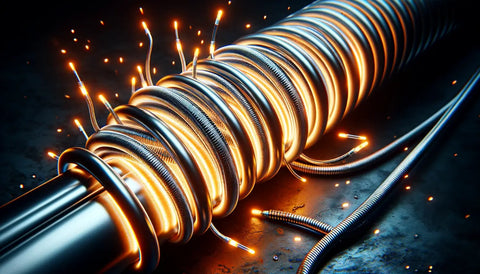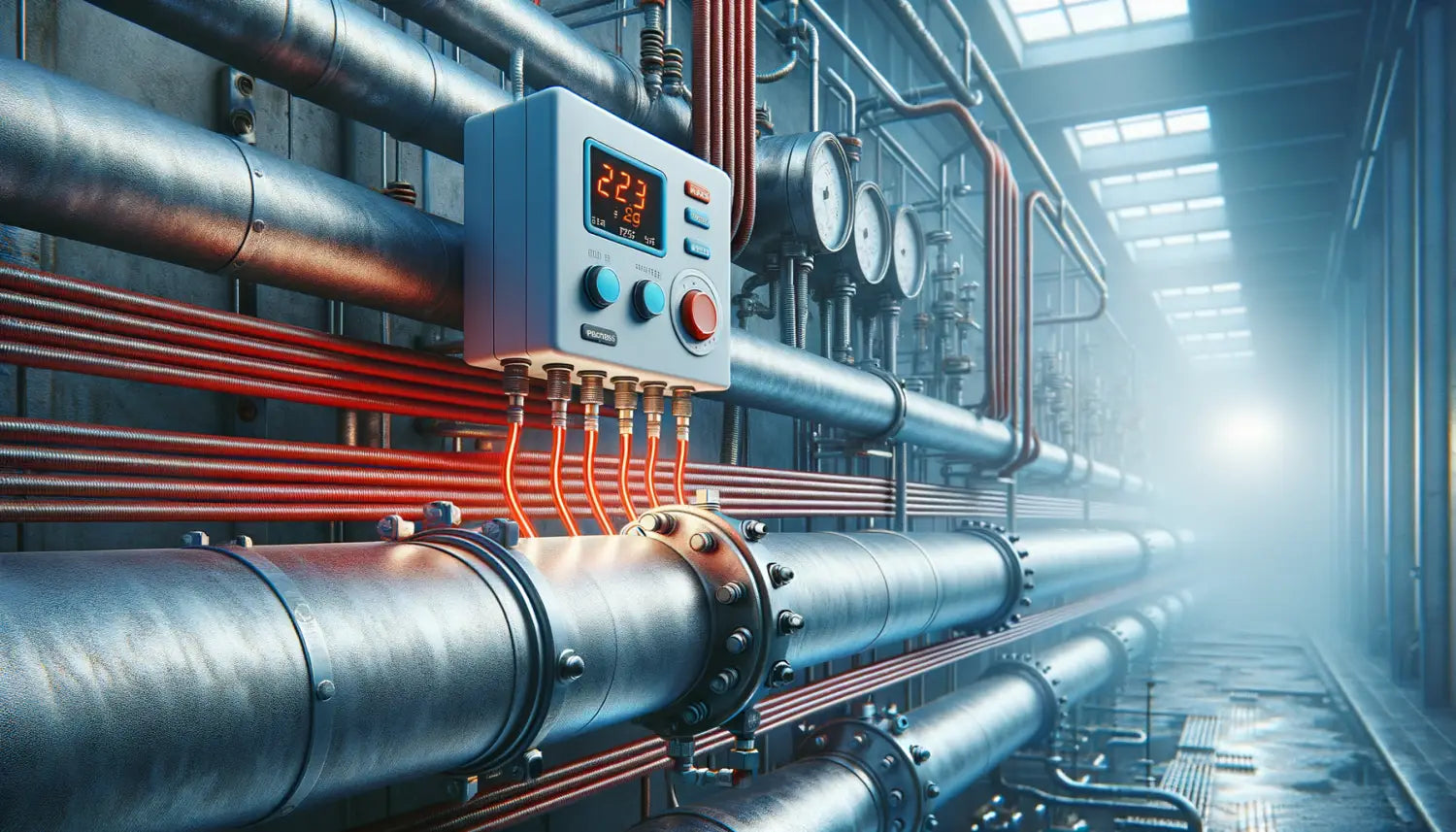Identifying the correct voltage is obviously essential for ensuring the safety and efficiency of your trace heating applications We'll discuss why later on, but first, Trace heating voltage refers to the electrical voltage applied to heating cables or tapes, which are used to maintain or raise temperatures in pipes, tanks or other equipment. We will cover the optimal voltage for trace heating and discuss factors that influence the selection of this voltage, ensuring that your trace heating system operates safely and efficiently.
Key Takeaways from Trace Heating Voltage
| Category | Description |
|---|---|
| Basic Understanding of Trace Heating | Trace heating systems maintain or increase the temperature of pipes and vessels to prevent freezing or maintain material flow. |
| Voltage Options | Options include low voltage (12-24V) for safety in residential applications, standard voltage (110-120V) for commercial use, and high voltage (208V+) for demanding industrial settings. |
| Heating Cable Types | Self-regulating, constant wattage, and mineral insulated cables are available. Voltage and cable type selection depend on specific application needs. |
| Applications for Different Settings | Voltage requirements vary across applications, from pipe freeze protection to snow melting systems, and sector-specific needs in residential, commercial, and industrial domains. |
| Maintenance and System Longevity | Regular maintenance checks ensure the longevity of the system and prevent unexpected failures. Correct voltage selection impacts system durability. |
| Technical Power Specifications | Power requirements and electrical resistance must be considered when selecting voltage to ensure efficient and safe operation. |
| Heat Tracing for Efficiency | Heat tracing prevents heat loss, ensuring energy-efficient operation and continuous functionality. |
| Safety and Compliance | Compliance with safety regulations is essential. Voltage selection and overheating protection mechanisms are critical for safe system operation. |
| Best Practice Tips | Proper installation, choosing the right voltage, and future-proofing the system are crucial for optimal performance. |
| Energy Efficiency through Insulation | Insulation works hand in hand with heating cables to reduce heat loss and improve energy efficiency, which may allow for lower voltage use. |
Trace heating technology is a convenient option for preventing freezing or maintaining process temperatures. This method entails the installation of heating cables or tapes along the length of the system, which are then powered by an electrical source. The electrical voltage for trace heating is critical for powering these cables and tapes efficiently, and we will dive into this topic fully in this article. The trace heating system voltage, or the voltage at which the system will operate, plays a crucial role in determining the heat output and safety of your trace heating application.

So, what is the standard voltage used for trace heating systems in the United Kingdom? Typically, the optimal voltage for trace heating is 230 volts. However, certain factors such as the length of the heating cable, ambient conditions and desired heat output may influence the voltage requirements. We will explore these factors and discuss how they affect the optimal voltage selection for your trace heating system.
Understanding Trace Heating
Before delving into the optimal voltage for trace heating, we need to first comprehend what trace heating is and how it works. Trace heating systems prevent freezing or maintain process temperatures in various equipment, such as pipes, tanks, and valves.
This is achieved by installing heating cables or tapes along the length of the equipment to maintain or raise temperatures that may be at risk of dropping due to external factors, such as ambient temperature.
The trace heating power supply for these cables or tapes is typically an electrical source. By supplying a constant flow of electrical energy, heat is generated, raising or maintaining the temperature of the equipment.
The electrical voltage for trace heating depends on various factors, such as cable length, heat output, and the ambient temperature, among others. Finding the optimal voltage for your specific application requires careful attention to detail and the assistance of a qualified professional or engineer.
Standard Voltage for Trace Heating

In the United Kingdom, the standard voltage used for trace heating is typically 230 volts. This voltage is widely available in domestic and commercial electrical systems and is compatible with most trace heating cables and tapes found in the market. Using the standard voltage ensures compatibility and ease of installation for your trace heating system.
It is important to note that while the standard voltage is suitable for most applications, specific factors such as the length of the heating cable, the desired heat output, and the ambient conditions, can impact the voltage requirements. In such cases, it is advisable to consult with a qualified trace heating professional or engineer to determine the most suitable voltage for your specific needs.
Optimising your voltage selection ensures the longevity, safety, and efficiency of your trace heating system, providing peace of mind that your investment is protected in all circumstances.
Factors Influencing Voltage Selection
When determining the optimal voltage for your trace heating application, there are several factors to consider.
Heating Cable Length
The length of your heating cable or tape plays a significant role in the voltage requirement. Longer cables will experience more voltage drop, resulting in less heat output. A higher voltage may be necessary to compensate for this drop.
Desired Heat Output
The heat output required for your application will also impact the voltage selection. A higher voltage will deliver more heat output, but it's essential to avoid exceeding the maximum temperature rating of the cable.
Ambient Conditions
The ambient conditions, such as the pipe size, insulation level, and the temperature range, will influence the voltage selection. For example, pipes in colder environments may require a higher voltage to maintain the desired temperature.
It is crucial to consult with a qualified trace heating professional or engineer to determine the most suitable voltage for your specific needs. A professional assessment will ensure optimal performance and safety for your trace heating system.
Conclusion
In conclusion, we have explored the standard voltage used for trace heating systems in the United Kingdom. It is important to note that the optimal voltage for your specific application may vary based on various factors such as the length of the heating cable, the desired heat output, and the ambient conditions. Therefore, we recommend consulting with a qualified trace heating professional or engineer to determine the most suitable voltage for your trace heating system.
By ensuring the correct voltage is used for your trace heating application, you can ensure the safety and efficiency of your system. The standard voltage of 230 volts is typically used for trace heating in the United Kingdom as it is compatible with most trace heating cables and tapes available in the market.
Thank you for taking the time to read this article on trace heating voltage. For more information and expert advice on trace heating systems and solutions, contact us today.
FAQ
What is trace heating?
Trace heating is a method of maintaining or raising temperatures to prevent freezing or maintain process temperatures in pipes, tanks, or other equipment. It involves installing heating cables or tapes along the length of the system, which are then powered by an electrical source.
What voltage is used for trace heating?
The standard voltage used for trace heating in the United Kingdom is typically 230 volts. This voltage is commonly found in domestic and commercial electrical systems and is compatible with most trace heating cables and tapes available in the market.
Are there factors that influence voltage selection for trace heating?
Yes, there are factors that may influence the optimal voltage selection for trace heating. Factors such as the length of the heating cable, the desired heat output, and the ambient conditions can impact the voltage requirements. It is recommended to consult with a qualified trace heating professional or engineer to determine the most suitable voltage for your specific needs.
Why is it important to consider the voltage for trace heating?
Considering the voltage for trace heating is crucial to ensure the safety and efficiency of your trace heating system. Using the correct voltage ensures compatibility and ease of installation of trace heating cables and tapes. It also helps in maintaining the desired heat output and preventing any electrical hazards.
How can I determine the optimal voltage for my trace heating application?
To determine the optimal voltage for your trace heating application, it is recommended to consult with a qualified trace heating professional or engineer. They will assess factors such as the length of the heating cable, the desired heat output, and the ambient conditions to recommend the most suitable voltage for your specific needs.





















































